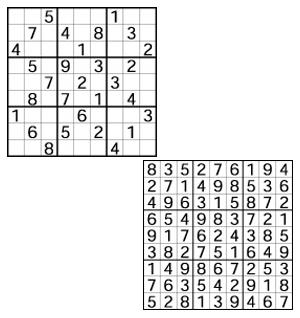Sudoku's Beautiful Symmetry
Sudoku number puzzles are booming. Major dailies and in-flight magazines carry them. Kiosks and bookshops purvey a bewildering array of titles. Don't know how to do Sudoku? Now you can pick up Sudoku for Dummies. Sudoku are published in over 70 countries, and puzzlers number around 80 million.
by Arjen van Blokland

The Sudoku puzzle board comprises a nine-by-nine grid subdivided into nine smaller grids of three-by-three boxes. To solve the puzzle, each row, column and box must contain each of the numerical digits 1 to 9.
The name 'Sudoku' suggests the roots of the puzzle lie in Japan. But Sudoku is not of Japanese origin. Latin squares that appear in Arabic literature over 700 years ago are believed to be the ancestors of Sudoku. Swiss mathematician Leonhard Euler discovered these squares in the eighteenth century. Latin squares are grids in which numbers, letters or symbols are written in such a way that none appear twice in the same row or column. Back in the 1970s, Dell Magazines introduced the first "Number Place" puzzle, which has exactly the same format as Sudoku. It was this magazine that Kaji Maki (54), president of Japanese puzzle publisher Nikoli, picked up in 1984. Two years later, he started to publish Sudoku puzzles in his company's own puzzle magazine. Maki called the number puzzle "suji wa dokushin ni kagiru" (the number must be single). In 1988, he abbreviated the name to "Sudoku" - "su" meaning number and "doku" single.
Sudoku's popularity gradually rose over time in Japan. In 2000, Nikoli caught the attention of a retired New Zealand judge named Wayne Gold, who had written a computer program to generate Sudoku. He visited Nikoli and obtained permission to introduce the puzzle abroad. In November 2004, the first handmade Sudoku was published in The Times in England, triggering a Sudoku craze in Britain. In the following year the puzzles were published in the New York Post. From Gotham, Sudoku swept across the US.
Not all Sudoku you see are made by Nikoli. Although Nikoli registered the Sudoku trade name in Japan, the name is not protected overseas; so anyone outside Japan can use it. What sets Nikoli apart is that all of its puzzles are handmade. Nikoli's puzzle setters have introduced an arrangement of cells that is symmetrical relative to the center of the board. Maki does not like computer-generated puzzles. "Our Sudoku creators are artists," he says.
"The reason why Sudoku boomed worldwide in such a short time is that everybody, independent of language or culture, understands numbers. The same Sudoku puzzle can be used in any country around the world, while this would be impossible for crossword puzzles."
Maki is widely regarded as the Godfather of Sudoku. He is invited to large competitions worldwide where puzzlers must solve as many Sudoku as they can within a limited time. "While these events have good promotional value, I always stress that solving Sudoku is for relaxing and taking your mind off daily sorrows," continues Maki. Nikoli has copyright agreements with many overseas companies for the distribution of handmade Sudoku.
Maki is not seeking to aggressively grow his business. "Nikoli must remain small, creative, and exclusive. Furthermore, if you don't have a vision or business objectives, you can't fail," he laughs.
Maki's shop is indeed a small-scale operation - just 20 workers (7 full-time puzzle creators) run the business, including nationwide distribution. In addition to the full-time puzzle creators, Nikoli uses a pool of 80 free-lancers. Maki's mild, easy-going personality fosters a laid-back atmosphere where the staff can focus on making high-quality puzzles for worldwide Sudoku buffs rather than worry about sales targets.
Despite his relaxed attitude, Maki does not shy from doing business with large companies. Recently Nintendo introduced a Sudoku game for its Nintendo DS, with Nikoli's handmade puzzles stored on the memory card.
For those who are bored with the nine-by-nine puzzles, Nikoli has created 25-by-25 Sudoku. "These are for hard-core puzzlers. Extremely challenging to solve but still made by hand and completely symmetric," says Maki.
In Nikoli's offices, located not far from Asakusa's Sensoji Temple in downtown Tokyo, Maki's creators are working on what may next sweep the puzzle world - Kakuro, from Japanese 'kasan kurosu' ('addition and across'). Kakuro are similar to cross sum puzzles. As in the case of Sudoku, Maki took the concept from abroad, improved its visual appeal through introducing symmetry, and renamed it Kakuro. Earlier this year Nikoli started distributing Kakuro abroad. The Kappa Publishing Group now reprints Nikoli's Kakuro in Games Magazine in the US. The Guardian introduced the British public to Kakuro with the publication of the puzzle under the Japanese name in 2005.
Kakuro is already second in popularity to Sudoku in Japan. When asked if Kakuro will become as successful as Sudoku, Maki replied, "I've no idea how the Kakuro business will develop. We are happy as long as our fans like the puzzles." JI
NIKOLI Co., Ltd.
4-17-10, Kuramae, Taito-ku,
Tokyo, Japan
www.nikoli.co.jp





